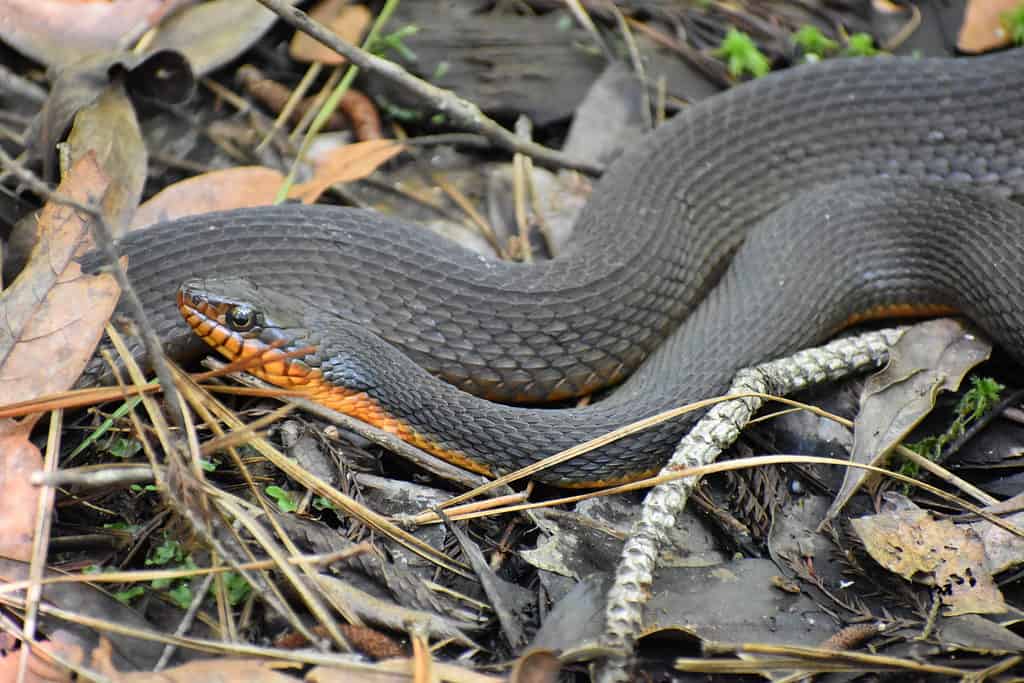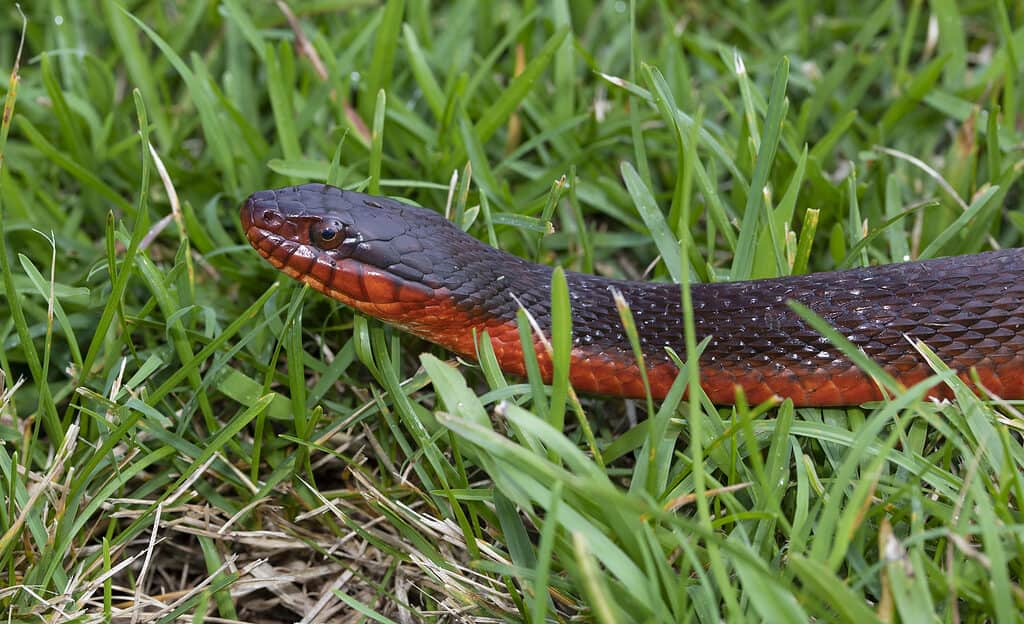While the red-bellied water snake might look like a formidable water moccasin, these snakes are not as threatening as they may seem. In fact, they have a host of characteristics that make them both a unique and impressive species. Furthermore, conservation of the red-bellied water snake and its subspecies is key to supporting the functionality of its environment. Discover the possible dangers of the red-bellied water snake and where it can be found.
Red-Bellied Water Snake Description
Appearance
Red-bellied water snakes are beautiful, non-venomous creatures that live near bodies of water. Their scales are keeled, meaning they have a texture that is rough, rather than smooth, to the touch. They measure between 30 and 48 inches in length. Female red-bellied water snakes are typically larger than their male counterparts.
Young red-bellied water snakes have dark stripes that start at their neck and fade away down the length of the snake’s body. The coloration of a juvenile red-bellied water snake camouflages them from predators that might try to attack them. Eventually, though, the stripes on a young snake will fade away as they age.
Adult red-bellied water snakes have a brown or gray scales with a stark and brightly colored orange or yellow belly. In many cases, their belly may appear red, hence their common name “red-bellied.”

Red-bellied water snakes have scales that are keeled (rough) and a brightly colored orange or yellow belly.
©NC Wetlands / Flickr – License
Behavior
The red-bellied water snake is unique in their behavior when compared to other snake species. While most water snakes that are confronted by a predator will slither into the water, the red-bellied water snake will leave the water and hide in nearby vegetation or brush.
During an instance in which a red-bellied water snake cannot hide in nearby brush and vegetation, the snake will trick a predator into believing that it is venomous. The snake will attack other animals and produce an odor that smells unpleasant. The action is likely to trick the predator into believing that the red-bellied water snake does secrete venom, and the predator may retreat for fear of being poisoned.
The prey of the red-bellied water snake is diverse. This snake species is likely to attack and eat any small animals such as fish and frogs. Amphibians are the red-bellied water snake’s favorite prey to feed on. These snakes are most active at sunrise and sunset because they are exothermic. Their body temperature fluctuates according to their environment, so during the heat of the day, red-bellied water snakes are not active.

Confronted by a predator the red-bellied water snake will leave the water and hide in nearby vegetation or brush.
©iStock.com/gsagi
Reproduction
Female red-bellied water snakes can give birth to up to 50 offspring per year, and birth often occurs at the beginning of autumn. While most snake species lay eggs, the red-bellied water snake gives live birth. This uncommon reproductive strategy is due to a host of environmental factors and makes this species unique. Snake eggs are typically threatened by predation. Therefore, live birth allows the young of a red-bellied water snake to protect themselves. The chances of being attacked by a predator decrease in this way.
Population and Habitat
Red-bellied water snakes are very common, so most states do not protect them nor make efforts toward conservation of the species. Unfortunately, red-bellied water snakes are threatened by habitat loss, especially in wetlands. The state of Georgia protects the red-bellied water snake, and other states protect the subspecies of this snake.
Subspecies of the red-bellied water snake include the copperbelly water snake, the northern red-bellied snake, and the Florida red-bellied snake. These subspecies can be found in states like Tennessee, Florida, and Georgia. While the red-bellied water snake and its subspecies once occupied a larger range, such as the Midwest, their numbers have greatly declined in these regions.
Copperbelly water snake populations have declined in Michigan, Ohio, and Indiana. In Michigan, the species is considered endangered. Population decline for the copperbelly water snake is due to habitat loss, habitat fragmentation, and the illegal snake trade. If the species’ population numbers continue to decline, adverse effects could harm other animals in the copperbelly water snake’s environment.
In many cases, people mistake the red-bellied water snake for other species that pose a larger threat. These similar species include the cottonmouth or water moccasin and the red-bellied black snake. The cottonmouth and the red-bellied black snake are both poisonous snakes, but the red-bellied black snake is native to Australia. Therefore, while the red-bellied black snake looks like the red-bellied water snake, the two species are unlikely to be mistaken for one another from separate locations. On the other hand, some people will accidentally kill a red-bellied water snake thinking that it’s a venomous cottonmouth.

Red-bellied water snakes are non-venomous, however they are aggressive and will bite if threatened.
©iStock.com/Rachel Fleming
Are Red-Bellied Water Snakes Dangerous?
Red-bellied water snakes are non-venomous, so they do not pose much of a threat to humans. However, these snakes can be aggressive. The species will often bite hard and fast when provoked or threatened. Furthermore, the teeth of the red-bellied water snake are long and sharp, meaning a bite from this snake could leave a serious wound.
Where Do Red-Bellied Water Snakes Live?
The red-bellied water snake lives in areas between the states of Virginia and Florida. However, they do not live near mountains nor in southeast Georgia and only reside in the upper portion of Florida. Their main habitat consists of swamps, rivers, lakes, and wetlands.
Up Next
- Cottonmouth versus Water Snakes: The Main Differences
- 8 Snakes You’ll Find in the South’s Swamps
- 10 Black Snakes in Georgia
The photo featured at the top of this post is © iStock.com/gsagi
Discover the "Monster" Snake 5X Bigger than an Anaconda
Every day A-Z Animals sends out some of the most incredible facts in the world from our free newsletter. Want to discover the 10 most beautiful snakes in the world, a "snake island" where you're never more than 3 feet from danger, or a "monster" snake 5X larger than an anaconda? Then sign up right now and you'll start receiving our daily newsletter absolutely free.
Sources
- Ashlyn Halseth, Available here: https://gwf.org/red-belliedwatersnake/
- Emily Rogers, Available here: https://srelherp.uga.edu/snakes/nerery.htm
- Project Noah, Available here: https://www.projectnoah.org/spottings/406636029#:~:text=This%20snake%20is%20not%20venomous,teeth%20embedded%20in%20its%20bite
- U.S. Fish and Wildlife Service, Available here: https://www.fws.gov/species/copperbelly-water-snake-nerodia-erythrogaster-neglecta
- Jillian Farkas, Available here: https://content.govdelivery.com/accounts/MIDNR/bulletins/cd9101
- Tennessee Wildlife Resources Agency, Available here: https://www.tn.gov/twra/wildlife/reptiles/snakes/red-bellied-snake.html#:~:text=This%20secretive%2C%20but%20easily%20recognizable,two%20subspecies%20interbreed%20as%20well
- Gordon Wilson, Available here: https://www.mysnakepet.com/red-bellied-water-snake/
FAQs (Frequently Asked Questions)
Are red-bellied water snakes dangerous?
Red-bellied water snakes are non-venomous, so they don’t pose a large threat. However, they are aggressive and will bite if threatened.
Where do red-bellied water snakes live?
Red-bellied water snakes live in regions between northern Florida and Virginia and in and near lakes, swamps, wetlands, and rivers.
Are red-bellied water snakes endangered?
Red-bellied water snakes are not endangered, but they are protected in some states. Some subspecies of this snake are considered endangered species.
Thank you for reading! Have some feedback for us? Contact the AZ Animals editorial team.






